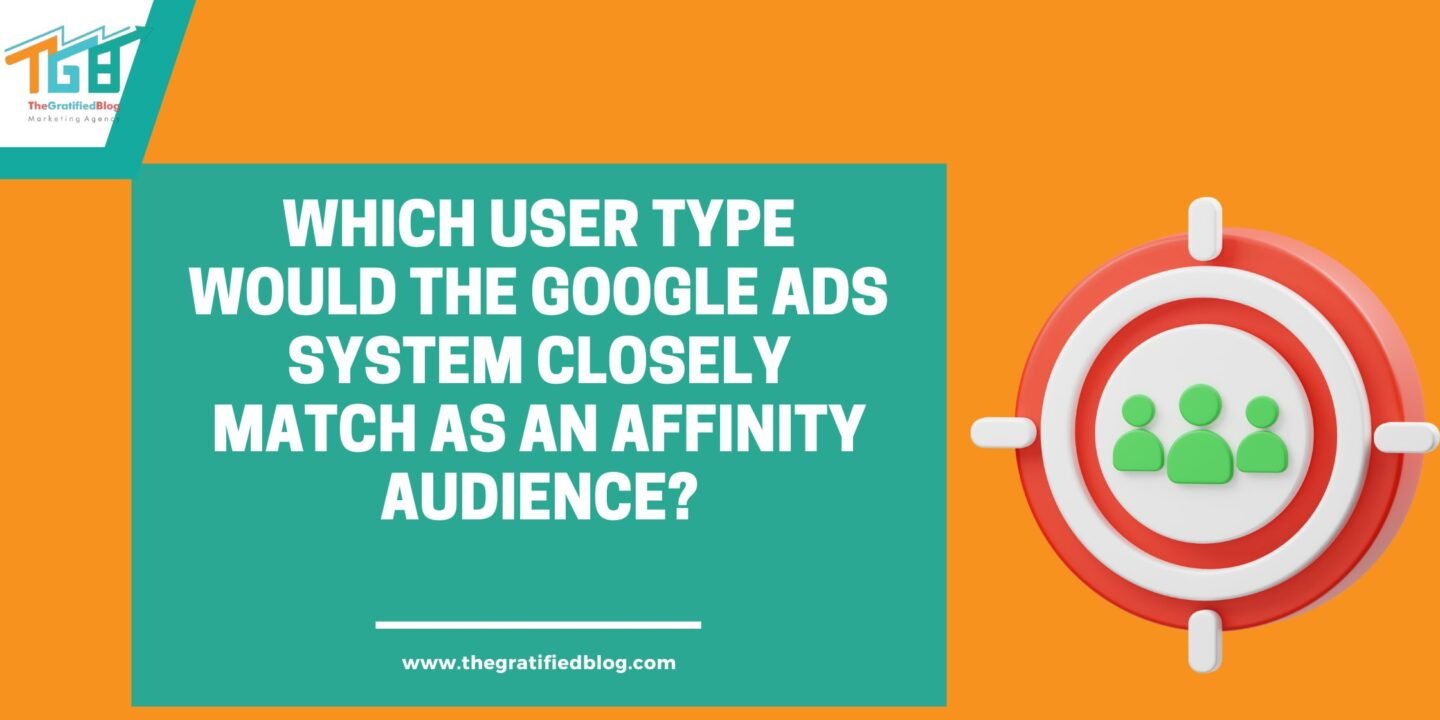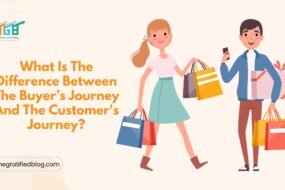
Affinity audiences in Google Ads are predefined audience segments designed to help advertisers reach people who have demonstrated a strong interest in specific topics, industries, or activities. These audiences are built by analyzing users’ online behavior, such as search queries, website visits, and content consumption. Google categorizes users into different affinity audience segments based on their demonstrated interests and habits.
In this context, advertisers often wonder, “Which user type would the Google Ads system closely match as an affinity audience?” This question is crucial for tailoring ad campaigns effectively. Advertisers can then target their ads specifically to these affinity audiences to reach potential customers more likely to be interested in their products or services.
For example, suppose you’re a sports equipment retailer. In that case, you can use an affinity audience like “Sports and Fitness Enthusiasts” to show your ads to people with a demonstrated interest in sports and fitness-related content.
Affinity Audiences With Examples: What Are They?
Affinity audiences, in the context of online advertising, refer to specific audience segments or groups of users who have demonstrated a solid and ongoing interest in particular topics, industries, or activities. Online platforms like Google Ads create and define these audience segments based on users’ online behavior, interests, and preferences.
Google categorizes users into affinity audiences based on their online behavior and interests by analyzing various data collected through its platforms and services. Here’s a simplified overview of how this process works:
- Data Collection: Google collects data from users across its ecosystem, including but not limited to:
- Search Queries: Google records the search queries users enter into its search engine. These queries can provide insights into users’ interests and intent.
- Website Visits: Google tracks which websites users visit through its advertising and analytics tools, as well as through cookies and other tracking technologies.
- YouTube Activity: Google owns YouTube, and it monitors users’ video views, likes, dislikes, and comments to understand their video preferences.
- App Usage: For users who are logged into Google accounts on their mobile devices, Google may collect data on app usage, which can reveal their interests and activities.
- Location Data: Google can track users’ physical locations through their mobile devices, which may provide insights into their behaviors and preferences.
- Ad Interaction: Google tracks how users interact with ads, such as clicks, conversions, and views.
- Data Analysis and Machine Learning: Google uses advanced data analysis methodologies and machine learning algorithms to process and make sense of this vast data. Through pattern recognition and data mining, Google identifies commonalities and trends among users’ online behaviors and interests.
- Segmentation: Based on the analysis, Google creates predefined audience segments, including Affinity Audiences. These segments are organized around specific topics, industries, or interests. For example, Google might create segments like “Travel Enthusiasts,” “Tech Enthusiasts,” or “Foodies.”
- User Assignment: Google assigns users to these predefined segments based on their observed online behavior and interests. Users who have exhibited a consistent pattern of engagement with content related to a particular topic or interest are grouped into the corresponding affinity audience segment.
- Audience Targeting: Advertisers using Google Ads can select these affinity audiences as part of their targeting criteria when creating advertising campaigns. When advertisers target a specific affinity audience, their ads are displayed to users within that audience segment.
Here are examples of familiar affinity audiences that advertisers can target:
a. Auto Enthusiasts: These users have a strong interest in automobiles, including topics like car reviews, racing, automotive news, and car accessories.
b. Travel Buffs: This audience comprises individuals passionate about travel, vacation planning, and exploring new destinations.
c. Fitness Enthusiasts: These users are interested in fitness, exercise routines, gym equipment, health and wellness, and related topics.
d. Home Decor and DIY Enthusiasts: This audience includes individuals who enjoy home improvement projects, interior design, DIY (do-it-yourself) home decor, and related content.
e. Tech Enthusiasts: Tech enthusiasts have a strong interest in technology, gadgets, electronics, and the latest innovations in the tech industry.
f. Movie Lovers: This audience segment consists of avid moviegoers who enjoy watching films and are interested in cinema-related content.
g. Foodies: Foodies are passionate about food, cooking, dining out, culinary experiences, and food-related content.
So, the question is:
Which User Type Would The Google Ads System Closely Match As An Affinity Audience?
An individual who has proven to have a legitimate interest in movies is the correct answer.
The Google Ads system closely matches users to Affinity Audiences based on their online behavior and interests. An example of such an affinity audience would be “Movie Lovers.” This audience comprises individuals who have proven to have a legitimate interest in movies. They may have demonstrated this interest by frequently searching for movie-related information, watching trailers, reading reviews, and engaging with movie-related content online.
Advertisers can target this affinity audience to effectively reach users passionate about films, thereby increasing the chances of their ads resonating with this specific group of individuals and potentially driving conversions within the realm of movies and entertainment.
- How Can Advertisers Set Up and Use Affinity Audiences in Their Google Ads Campaigns?
To set up and use Affinity Audiences in Google Ads campaigns, advertisers can follow these steps:
- Sign in to Google Ads: Log into your Google Ads account or establish one if you still need to.
- Create a New Campaign or Edit an Existing Campaign: Initiate a new campaign or generate one and edit an existing one to incorporate Affinity Audiences into your targeting.
- Select Campaign Settings:
- Choose your campaign type if creating a new campaign (e.g., search, display, video).
- Set your budget, bid strategy, and other settings as needed.
- Choose Your Campaign Goals: Depending on your campaign type, specify your campaign goals, such as website traffic, conversions, or brand awareness.
- Set Up Ad Groups: Within your campaign, create ad groups relevant to the products or services you want to promote.
- Choose Your Audience Targeting:
- Find the “Audiences” or “Placements” section in the ad group settings.
- Click on “Audiences” to access targeting options.
- Select “Browse” or “Search”: You can browse through the available audience categories or use the search bar to find specific Affinity Audiences.
- Choose Affinity Audiences: Locate and select the Affinity Audiences that align with your target audience’s interests and behaviors. You can add multiple Affinity Audiences to a single ad group if relevant.
- Adjust Bid Adjustments (Optional): To prioritize your ad delivery to the selected Affinity Audiences; you can make bid adjustments by raising or lowering your bids for these audiences to make your ads more competitive.
- Save Your Settings: Save your ad group settings after selecting Affinity Audiences and making any bid adjustments.
- How do affinity audiences benefit advertisers?
Affinity audiences benefit advertisers by:
- Increased Relevance: Ads are shown to users with demonstrated interests, improving relevance.
- Cost-Efficiency: Reduced ad spend wastage, leading to better ROI
- Improved Performance: Higher click-through rates (CTR) and conversion rates
- Audience Segmentation: Customized messaging for different audience segments
- Retargeting: Effective retargeting of users who have engaged with the brand
- Brand Building: Enhanced brand awareness and loyalty
- Ad Personalization: Personalized ads create a positive user experience
- Competitive Advantage: Targeting the right audience gives a competitive edge
Conclusion
The Google Ads system closely matches users to Affinity Audiences based on their online behavior and interests. One such example is “Movie Lovers,” an audience segment comprising individuals passionate about movies. By leveraging these affinity audiences, advertisers can refine their targeting, delivering tailored messages to genuinely interested audiences.
Do you have any thoughts or questions about affinity audiences and their impact on online advertising? Feel free to share your insights in the comments section below. We’d love to hear from you!








No Comments